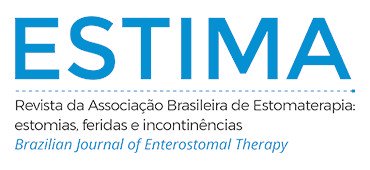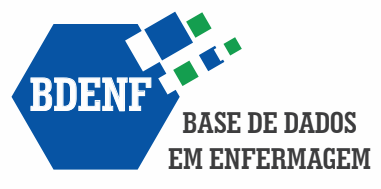VALIDITY AND RELIABILITY OF THE EXPECTED RESULTS OF THE EVALUATION OF CHRONIC WOUND HEALING (RESVECH 2.0)
Abstract
Introduction: Wounds that are difficult to heal are a health problem due to their high prevalence and multifactorial etiologies. Treatment begins with the prescription of the appropriate therapeutic agent, followed by the use of instruments that allow the professional to document wound assessments. Objective: The study aims to evaluate the reliability and validity of the Brazilian version of the RESVECH 2.0 instrument in the context of difficult-to-heal wounds. Methods: A methodological study was carried out. Initially, participants were interviewed in order to establish a profile; then evaluations of difficult-to-heal wounds of any etiology (n = 179) were performed with RESVECH 2.0 and Pressure Ulcer Scale for Healing 3.0 (PUSH 3.0) instruments. Results: The psychometric properties evaluated were convergent construct validity, interobserver reliability and internal consistency. Internal consistency reliability showed the values of 0.561 and 0.535. Interobserver reliability showed a Kappa value ranging from 0.14 to 0.76 and an intraclass correlation coefficient (ICC) of 0.87. For convergent construct validity, Spearman’s correlation coefficient was applied to RESVECH 2.0 and PUSH 3.0 scores (n = 150); the coefficient obtained was 0.717. Conclusion: It is concluded that the instrument showed evidence of reliability and validity.
Downloads
Metrics
References
Lima RVKS, Coltro OS, Farina Júnior JA. Terapia por pressão negativa no tratamento de feridas complexas. Rev Col Bras Cir 2017;44(1):81-93. https://doi.org/10.1590/0100-69912017001001
Järbrink K, Ni G, Sönnergren H, Schmidtchen A, Pang C, Bajpai R, et al. The humanistic and economic burden of chronic wounds: a protocol for a systematic review. Syst Rev 2017;6(1):15. https://doi.org/10.1186/s13643-016-0400-8
Murphy C, Atkin L, Swanson T, Tachi M, Tan YK, Ceniga MV, et al. Defying hard-to-heal wounds with an early antibiofilm intervention strategy: Wound hygiene. J Wound Care 2020;29(Sup3b):S1-S26. https://doi.org/10.12968/jowc.2020.29.Sup3b.S1
Domingues EAR, Carvalho MRF, Kaizer UAO. Adaptação transcultural de um instrumento de avaliação de feridas. Cogitare Enferm 2018;23(3):e54927. https://doi.org/10.5380/ce.v23i3.54927
Cardinelli CC, Lopes LPN, Di Piero KC, Freitas ZMF. Instrumentos para avaliação de feridas: Scoping review. Res Soc Dev 2021;10(11):e144101119246. https://doi.org/10.33448/rsd-v10i11.19246
Harris C, Bates-Jensen B, Parslow N, Raizman R, Singh M, Ketchen R. Bates-Jensen wound assessment tool: Pictorial guide validation project. J Wound Ostomy Continence Nurs 2010;37(3):253-9. https://doi.org/10.1097/WON.0b013e3181d73aab
Santos VLCG, Azevedo MAJ, Silva TS, Carvalho VMJ, Carvalho VF. Adaptação transcultural do Pressure Ulcer Scale for Healing (PUSH), para a língua portuguesa. Rev Latino-Am Enfermagem 2005;13(3):305-13. https://doi.org/10.1590/S0104-11692005000300004
Santos VLCG, Sellmer D, Massulo MME. Confiabilidade interobservadores do Pressure Ulcer Scale for Healing (PUSH), em pacientes com úlceras crônicas de perna. Rev Lat-Am Enferm 2007;15(3):391-6. https://doi.org/10.1590/S0104-11692007000300005
Restrepo-Medrano JC. Instrumentos de monitorización clínica y medida de la cicatrización en úlceras por presión (UPP) y úlceras de la extremidad inferior (UEI): Desarrollo y validación de um índice de medida [tese]. Alicante: Universidade de Alicante; 2010.
Restrepo-Medrano JC. Validación para Colombia del índice RESVECH 2.0 para la valoración de cicatrización en heridas crónicas. Revista Avances En Salud 2019;3(1):8-15. https://doi.org/10.21897/25394622.1748
Polit DF. Fundamentos de pesquisa em enfermagem. 9. ed. Porto Alegre: Artmed; 2019.
Meadows K, Bentzen N, Touw-Otten F. Cross-cultural issues: An outline of the important principles in establishing cross-cultural validity in health outcome assessment. In: Hutchinson A, Bentzen N, König-Zahn C, editors. Cross Cultural Health Outcome Assessment: A user’s guide. Outcomes; 1996. p. 34-40.
Restepro-Medrano JC, Soriano JV. Desarrollo de um índice de medida de la evolución hacia la cicatrización de las heridas crónicas. Gerokomos. 2011;22(4):176-83. https://doi.org/10.4321/S1134-928X2011000400005
Restrepo-Medrano JC, Soriano JV. Development of a wound healing index for chronic wounds. EWMA Journal. 2012;12(2):39-44.
Silva JA. Confiabilidade interobservadores e responsividade da escala Resvech 2.0 “Resultados esperados de la valoración y evaluación de la cicatrización de las heridas crónicas” [dissertação]. Niterói: Universidade Federal Fluminense; 2019.
Santos VLCG, Carvalho VF. Atualização. ESTIMA Braz J Enterostomal Ther 2009;7(2).
Choi EP, Chin WY, Wan EY, Lam CL. Evaluation of the internal and external responsiveness of the Pressure Ulcer Scale for Healing (PUSH) tool for assessing acute and chronic wounds. J Adv Nurs 2016;72(5):1134-43. https://doi.org/10.1111/jan.12898
Garbuio DC, Zamarioli CM, Silva NCM, Oliveira-Kumakura ARS, Carvalho EC. Instrumentos para avaliação da cicatrização de lesões de pele: revisão integrativa. Rev Eletr Enf 2018;20:40. https://doi.org/10.5216/ree.v20.49425
Souza AC, Alexandre NMC, Guirardello EB. Psychometric properties in instruments evaluation of reliability and validity. Epidemiol Serv Saude 26(3):649-59. https://doi.org/10.5123/s1679-49742017000300022
Landis JR, Koch GG. The measurement of observer agreement for categorical data. Biometrics 1997;33(1):159-74.
Mukaka MM. Statistics corner: A guide to appropriate use of correlation coefficient in medical research. Malawi Med J 2012;24(3):69-71.
Marques JMND. Adaptação cultural e validação para a população portuguesa de um instrumento de monitorização de feridas crónicas – Escala RESVECH 2 [dissertação]. Lisboa: Universidade Católica Portuguesa; 2016.
Mokkink LB, Prinsen CA, Patrick DL, Alonso J, Bouter LM, Vet HC et al. COSMIN Study Design checklist for patient-reported outcome measurement instruments. Amsterdã: COSMIN; 2019. [cited 2 aug 2022]; Available at: https://www.cosmin.nl/wp-content/uploads/COSMIN-study-designing-checklist_final.pdf
Pasquali L. Psicometria: Teoria dos testes na psicologia e na educação. Petrópolis: Vozes; 2003.
Stotts NA, Rodeheaver GT, Thomas DR, Frantz RA, Bartolucci AA, Sussman C, et al. An instrument to measure healing in pressure ulcers: Development and validation of the pressure ulcer scale for healing (PUSH). J Gerontol A Biol Sci Med Sci 2001;56(12):M795-9. https://doi.org/10.1093/gerona/56.12.M795
Dowsett C. Using the TIME framework in wound bed preparation. Br J Community Nurs 2008;13(6):S15-21. https://doi.org/10.12968/bjcn.2008.13.sup3.29468
Eagle M. Wound assessment: The patient and the wound. Wound Essent 2009;4:14-24.
Milic DJ, Zivic SS, Bogdanovic DC, Karanovic ND, Golubovic ZV. Risk factors relatedto the failure of venous leg ulcers to heal with compression treatment. J Vasc Surg 2009;49(5):1242-7. https://doi.org/10.1016/j.jvs.2008.11.069
Downloads
Published
How to Cite
Issue
Section
License
Copyright (c) 2023 Fernanda Maria Vieira da Cruz, Elaine Aparecida Rocha Domingues, Thais Moreira São-João, Uiara Aline de Oliveira

This work is licensed under a Creative Commons Attribution 4.0 International License.

























